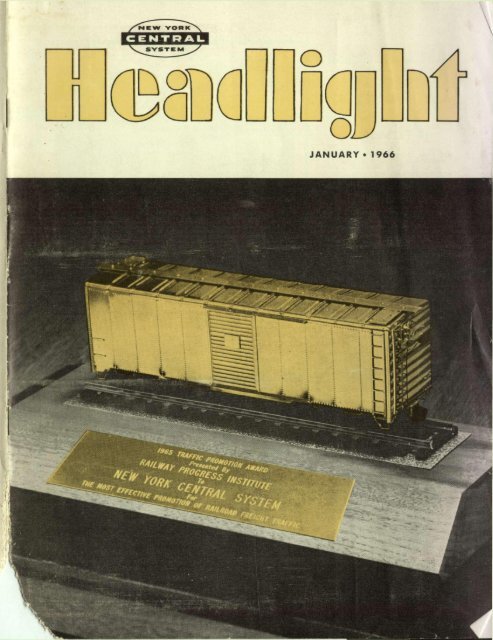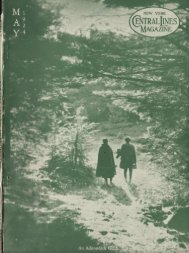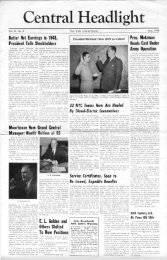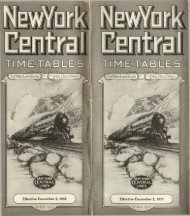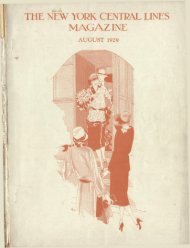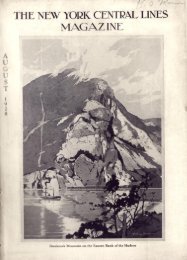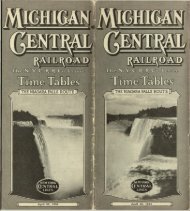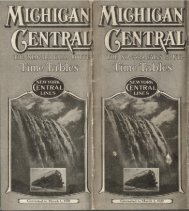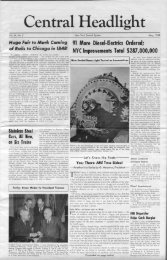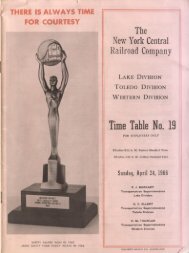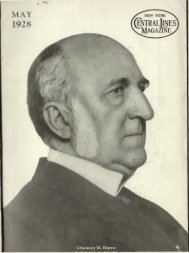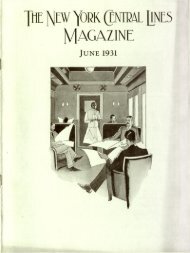flexi-flo - Canada Southern Railway
flexi-flo - Canada Southern Railway
flexi-flo - Canada Southern Railway
Create successful ePaper yourself
Turn your PDF publications into a flip-book with our unique Google optimized e-Paper software.
Headlight<br />
JANUARY, 1966<br />
Vol. 27 43 No. 1<br />
Printed in U.S.A.<br />
IN THIS ISSUE<br />
NYC WINS 1965 GOLDEN FREIGHT<br />
CAR AWARD 3<br />
NYC PRESIDENT PROPOSES<br />
NATIONAL COMPUTER COMPLEX 6<br />
114th VALOR MEDAL HONORS<br />
CENTRAL MAN 7<br />
HEADLIGHT HIGHLIGHTS . . . . 8<br />
PROMOTIONS 10<br />
CENTRALINES AND HISTORY 11<br />
RETIREMENTS 12<br />
RETIREMENT ACT CHANGES WILL<br />
INCREASE PAYROLL DEDUCTIONS 14<br />
1966 CALENDAR 15<br />
NORMAN M. STONE<br />
Manager, Publications & Advertising<br />
HAROLD J. SCHNEIDER, Editor<br />
SYDNEY OXBERRY, Art Editor<br />
EDITORIAL ASSOCIATES<br />
John E. Salter, Syracuse<br />
Frederic H. Woolfall, Cleveland<br />
Farwell C. Rhodes, Jr., Indianapolis<br />
Harry B. Spurrier, Chicago<br />
Robert W. Schuette, Boston<br />
Fred A. Huber, Jr., Detroit<br />
HEADLIGHT is published by the New York<br />
Central System for its active and retired<br />
employees and their families. All communications<br />
should be addressed to the<br />
HEADLIGHT editorial office: Room 1446, 466<br />
Lexington Ave., New York, N. Y. 10017.<br />
Member: Association of Railroad Editors,<br />
New York Association of Industrial Communicators,<br />
International Council of<br />
Industrial Editors.<br />
ON THE COVER: The 1965 Golden<br />
Freight Car Award presented by the<br />
<strong>Railway</strong> Progress Institute to the New<br />
York Central for its most effective<br />
promotion of Railroad Freight Traffic.<br />
2<br />
29 Million People...<br />
saw this locomotive at the 1964-65 World's Fair in New York. It was<br />
purchased by Central from General Motors at the close of the Fair last<br />
year. A regular production model, the locomotive was modified to make<br />
its innards more visible while on display at the GM Futurama exhibit at<br />
the Fair. Central's only structural change involved replacing a glass wall<br />
on the engineer's side of the cab with a conventional side. It is now in New<br />
York Central operation, where some of the ex-Fairgoers may get a chance<br />
to see her in action.<br />
NYC Passengers to get Smo-o-o-other Rides...<br />
now that Central's modern track machinery, shown in operation on the<br />
Hudson Division north of Peekskill, N.Y. has rebuilt roadbed and<br />
smoothed rails to provide better riding comfort. This machinery, capable<br />
of re-surfacing more than 1,000 feet of track per hour, also was in operation<br />
on the Harlem Division and during track maintenance season resurfaced<br />
115 miles of track, roadbed and installed 12,000 new cross-ties.<br />
New York Central Headlight<br />
CENTRAL WINS<br />
GOLDEN FREIGHT CAR<br />
FOR DEVELOPING<br />
& MARKETING<br />
FLEXI-FLO<br />
New York Central has been honored<br />
as 1965 winner of the "Golden Freight<br />
Car"—highest award of its kind in the<br />
railroad industry. The award, sponsored<br />
by the <strong>Railway</strong> Progress Institute, came<br />
to NYC for development of Flexi-Flo,<br />
a new concept of bulk freight handling,<br />
and for an intensive promotional campaign<br />
demonstrating customer benefits of<br />
the Flexi-Flo system.<br />
Using this new method, Central has<br />
reversed declines in bulk freight traffic<br />
and generated business from new customers.<br />
After a successful start in carrying<br />
cement, the Flexi-Flo concept is now<br />
being carried into a broader range of<br />
bulk-handling applications, representing<br />
a great potential in new traffic for all<br />
railroads.<br />
Results of the Flexi-Flo system include<br />
real economies in distribution, thus benefiting<br />
customers; creation of important<br />
new traffic for Central; improvement of<br />
truck utilization and increasing revenues<br />
for truckers working with the method;<br />
creation of new car demand with potential<br />
increased business for car builders;<br />
and pointing the way to all railroads to a<br />
new potential for bulk freight handling.<br />
The <strong>Railway</strong> Progress Institute is the<br />
national association of the railway equipment<br />
and supply industry. Each year<br />
RPI presents the "Golden Freight Car"<br />
for this four-fold purpose:<br />
1. To give recognition to railroads<br />
and their personnel for outstanding use<br />
of effective sales promotion and advertising<br />
techniques to sell railroad freight<br />
service;<br />
2. To spotlight effective methods of<br />
selling and promotion that will help the<br />
entire industry;<br />
3. To foster increased use of modern<br />
sales and merchandising methods to sell<br />
railroad freight service;<br />
4. And thereby to help promote<br />
greater freight traffic volume for the<br />
ailroad industry.<br />
NYC has previously won Citations of<br />
Merit six times during the eight-year<br />
history of the awards program. This is<br />
Central's first "Golden Freight Car."<br />
The "Golden Freight Car" was presented<br />
to NYC President Alfred E. Perlman<br />
by RPI Chairman Arthur H. Smith,<br />
who is also President of the Kerite Co.,<br />
at the Institute's annual meeting and<br />
dinner in Chicago. Prior to the presentation,<br />
the announcement had been made<br />
by RPI Vice Chairman W. Ashley Gray,<br />
Jr., President of General Steel Industries,<br />
Inc., at the dinner meeting of more than<br />
1,000 railroad and railway equipment<br />
and supply industry leaders from all<br />
parts of the country.<br />
In addition to the presentation of the<br />
top award to Mr. Perlman, smaller<br />
trophies were presented to New York<br />
Central people who had participated in<br />
development of the Flexi-Flo program<br />
and in preparation of NYC's entry in the<br />
awards program. They are Wayne M.<br />
Hoffman, Executive Vice President; Arthur<br />
E. Baylis, Vice President-Staff;<br />
James R. Sullivan, Vice President-Marketing;<br />
Douglass Campbell, Vice President<br />
(Public Relations & Advertising);<br />
Henry Hohorst, Director of Market<br />
Planning & Research; and Norman M.<br />
Stone, Manager of Publications & Advertising.<br />
Commenting on the award, Mr.<br />
Perlman said:<br />
"We may all take special pride in<br />
winning the "Golden Freight Car" award<br />
this year. While the award is for outstanding<br />
promotion of freight traffic, the<br />
New York Central family recognizes,<br />
perhaps more than others, that effectiveness<br />
in business development is the<br />
result of teamwork involving all departments.<br />
Nowhere is this more apparent<br />
than in the development of Flexi-Flo.<br />
"This award is a symbol of the progress<br />
made in many areas on the New<br />
York Central, and I extend my thanks<br />
to all the people who are helping to make<br />
New York Central truly the road to the<br />
future."<br />
PARTICIPATING in "Golden Freight Car" award, these Central men received small desk<br />
trophies with gold car, while major trophy went to NYC President Alfred E. Perlman.<br />
Seated (from left): Henry Hohorst, Director of Market Planning & Research; Mr. Perlman;<br />
and Wayne M. Hoffman, Executive Vice President. Rear (from left): Arthur E. Baylis, Vice<br />
President-Staff; Douglass Campbell, Vice President (Public Relations & Advertising);<br />
Norman M. Stone, Manager-Publications & Advertising; and James R. Sullivan, Vice<br />
President-Marketing.
FLEXI-FLO<br />
For the past several years New York<br />
Central has been disturbed by a steady<br />
decline in the volume of traffic in bulk<br />
freight. Central's Marketing department<br />
set out to find a means of arresting this<br />
trend through the development of a<br />
marketing program which would attract<br />
customer interest in rail service, regain<br />
lost business and create new and profitable<br />
bulk freight traffic.<br />
Undertaking this assignment, it was<br />
apparent to NYC's marketing specialists<br />
that something more than stepped-up<br />
sales efforts with existing facilities was<br />
needed. A fresh concept had to be found<br />
which would offer positive and substantial<br />
advantages to bulk freight shippers.<br />
Central's Marketing department conceived<br />
and developed the idea of a bulk<br />
freight system which would bring to<br />
customers in that classification the same<br />
dynamic advantages of faster service and<br />
reduction of inventory and storage requirements<br />
enjoyed by users of Central's<br />
Flexi-Van and auto carrier services.<br />
A bulk-hauling system, using specialized<br />
equipment and terminal facilities<br />
was developed to offer complete mill-toconsumer<br />
distribution service to the<br />
shipper through combined rail and highway<br />
transportation at an attractive joint<br />
through rate.<br />
Called Flexi-Flo, to reflect the <strong>flexi</strong>bility<br />
of service and the methods employed,<br />
and to capitalize on the well-established<br />
and recognized Flexi-Van name, the system<br />
offers the bulk shipper an impressive<br />
number of advantages:<br />
• elimination of packaging costs<br />
• substantial savings on distribution<br />
costs<br />
• single agency responsibility and billing,<br />
resulting in<br />
—simplification of traffic department<br />
load<br />
—traffic department economies<br />
• fast customer service—truck dispatch<br />
within one hour of customer's phone<br />
order<br />
• quality control through protection<br />
from contamination<br />
• reduction in capital demands for market<br />
expansion<br />
• extension of shippers' market radius<br />
These extra advantages are available<br />
to Flexi-Flo shippers without the need<br />
for capital investment on their part.<br />
Announcement of Flexi-Flo's availability—first<br />
to the cement industry—followed<br />
months of careful research, backed<br />
by Central's investment of $575,000 in<br />
equipment specially designed for the<br />
service.<br />
Cement offered an excellent market in<br />
which to prove the benefits Flexi-Flo<br />
holds for shippers and receivers of bulk<br />
freight, as well as for the railroads.<br />
Of the 70 million tons of cement<br />
produced annually in the United States,<br />
one-third comes from the area served by<br />
New York Central. A ten-year trend in<br />
volume of cement traffic was clearly<br />
away from rails. Trucks offered great<br />
speed and <strong>flexi</strong>bility for short distances,<br />
coupled with attractive rates.<br />
Flexi-Flo rates enabled Central to<br />
undercut truck rates for the first time in<br />
a decade and still return a profit to the<br />
railroad.<br />
Fast, <strong>flexi</strong>ble service, including good<br />
inventory control for the shipper, were<br />
added to attractive rail rates, enabling<br />
shippers to penetrate distant markets<br />
more effectively than was possible with<br />
trucks.<br />
With the feasibility of the concept<br />
established . . . with rates attractive to<br />
customers . . . with equipment ready for<br />
service . . . Flexi-Flo was ready to roll<br />
and recapture for New York Central an<br />
increasing volume of lucrative business.<br />
From the outset it was recognized that<br />
achievement of such a bold breakthrough<br />
in bulk commodity transportation would<br />
require the full coordination of Central's<br />
talents in Marketing, Equipment Engineering,<br />
Terminal Operations, Research,<br />
Transportation, Industrial Engineering,<br />
Sales, Public Relations and Advertising.<br />
All of these departments became<br />
deeply involved because no matter how<br />
sound the marketing approach might be,<br />
Flexi-Flo could not be taken out and<br />
sold to the cement industry or any other<br />
customer group without the establishment<br />
of adequate operational back-up.<br />
Sound management ;ii each Flexi-Flo<br />
terminal was essential to insure: rapid<br />
and dependable truck dispatch ... assured<br />
quality control through transfer<br />
and delivery . . . inventory control . . .<br />
expedited rail movements to the terminal.<br />
A full-time Flexi-Flo supervisor was<br />
lAt shipper's plant, bulk material<br />
is loaded into FLEXI-FLO car.<br />
This newest concept in specially<br />
designed freight cars provides lowest<br />
loading and unloading cost<br />
available - lower than package or<br />
bulk trucking costs.<br />
placed in charge of each terminal as it<br />
was established. As increased Flexi-Flo<br />
traffic developed, a system Flexi-Flo<br />
operations manager was appointed to<br />
follow up on train schedules, the opening<br />
of new terminals, and the operation of<br />
each new terminal.<br />
Each terminal location actually constitutes<br />
a dispatching center, with its own<br />
track scales, communications facilities,<br />
and exterior lighting to insure efficient<br />
operation at any hour, and coordinating<br />
Flexi-Flo shipments with complete customer<br />
delivery service.<br />
A special sales manager was appointed,<br />
charged with the responsibility for boosting<br />
Flexi-Flo sales efforts through campaigns<br />
directed initially at the cement<br />
companies, and later into other bulk<br />
shipper categories.<br />
Sales meetings were held to familiarize<br />
NYC salesmen throughout the System<br />
with Flexi-Flo and spur them to special<br />
sales efforts.<br />
Newspaper and magazine articles, advertising,<br />
direct mail brochures, demonstrations<br />
of equipment, special research<br />
for individual customers—all these were<br />
included in Central's promotional campaign<br />
to launch Flexi-Flo successfully.<br />
The response was immediate and has<br />
continued to grow. Through this Flexi-<br />
Flo marketing campaign, Central has<br />
been successful in gaining impressive<br />
4 New York Central Head''<br />
uary, 1966<br />
5<br />
HOW<br />
WORKS<br />
2 The car is then transported via<br />
NYC to the FLEXI-FLO Terminal<br />
nearest to the point of<br />
use.<br />
At the terminal, cement <strong>flo</strong>ws<br />
from rail cars to truck by pressure<br />
differential.<br />
new traffic and revenue volumes. This<br />
is all "plus" business—business which<br />
would have been lost to highway carriers<br />
without Flexi-Flo.<br />
In one year this bold new marketing<br />
approach converted an industry which<br />
gave virtually no business to the railroads<br />
into a substantial customer for the<br />
Central. And the future looks even better<br />
as Flexi-Flo's advantages are presented<br />
to other industries which ship freight in<br />
bulk.<br />
ft—<br />
At**<br />
SERVICE: ANSWER<br />
TO CUSTOMERS<br />
NEEDS<br />
TRUCK<br />
RAIL<br />
3 Trucker makes delivery at customer's<br />
site. The receiver requires<br />
only a simple, low-cost<br />
storage bin or tank, so deliveries<br />
are as uncomplicated as<br />
home delivery of fuel oil. He no<br />
longer needs .. •<br />
- His own terminal facilities<br />
- His own or contract trucks<br />
- Any local terminal or shipping<br />
personnel<br />
- Any capital outlay<br />
FLEXI-FLO ADVANTAGES<br />
1. TO CUSTOMERS:<br />
by providing real economies in distribution,<br />
and significantly broadening their<br />
geographic markets, without any capital<br />
expenditures.<br />
2. TO NEW YORK CENTRAL:<br />
by creating important new traffic and<br />
increased revenues and profits.<br />
3. TO TRUCKERS:<br />
by creating important new traffic and<br />
increasing revenues; by improving truck<br />
utilization through short haul nature of<br />
traffic; by centralizing truck pick-up at a<br />
single terminal.<br />
4. TO CAR BUILDERS:<br />
by creating new car demand, with<br />
potential for additional revenue in<br />
the construction of more sophisticated<br />
equipment.<br />
5. TO AMERICAN RAILROADS:<br />
by pointing the way to new potential for<br />
bulk freight handling for all lines . . .<br />
markets for the FLEXI-FLO system exist<br />
in every area.
NYC President Proposes National Computer Complex<br />
Delivering the keynote address to<br />
members of the <strong>Railway</strong> Systems and<br />
Management Association convening in<br />
Chicago recently, Alfred E. Perlman,<br />
NYC President, proposed a national computer<br />
complex and called for industrywide<br />
acceptance of new marketing techniques<br />
as solutions to the equipment<br />
utilization problem facing the nation's<br />
railroads. He pointed out that the railroads<br />
do not have a unified approach<br />
to improving equipment utilization. "We<br />
are relying on theories without facts to<br />
back them up, and we are resorting to<br />
out-moded, historical techniques which<br />
no longer fit the problem," he said.<br />
Mr. Perlman urged the railroad industry<br />
to establish a computer center—<br />
"perhaps in Chicago"—to keep a daily<br />
record of the approximately 1.8 million<br />
freight cars in the national car fleet. He<br />
also suggested "regional controls to keep<br />
track of seasonal variations."<br />
He noted that "at present, car service<br />
orders are issued by the Association of<br />
American Railroads and penalty orders<br />
by the Interstate Commerce Commission,<br />
without either agency having full<br />
and accurate knowledge of the facts."<br />
The Central, he stated, has spent millions<br />
of dollars on computer systems<br />
designed to provide accurate information<br />
and "can kill the theory upon which<br />
the service orders are based with facts."<br />
As the primary example of the equipment<br />
utilization problem, he said: "We<br />
recognize that there is, in fact, a seasonal<br />
shortage of grain cars. But, by the same<br />
New Type Grain<br />
Cars Are Hit With<br />
NYC Customers<br />
Zahl Elevator employees at<br />
New Carlisle, Ind. are enthusiastic<br />
about NYC's new covered<br />
hopper cars designed for<br />
the hauling of grain. The cars,<br />
a new rate structure and a<br />
staff of specialist advisers are<br />
the Central's way of tailoring<br />
its services to meet the changing<br />
needs of agriculture.<br />
Standing at the left in the picture<br />
are Peter P. Bornejko, NYC<br />
Division Freight Sales Manager,<br />
South Bend, Ind.; Mrs.<br />
Irma Brasseur, Elevator Office<br />
Manager; Carl Zahl, Jr., Elevator<br />
Manager, and Glen<br />
Hoover, NYC Traveling Agent,<br />
Rolling Prairie, Ind.<br />
6<br />
token, at other than peak harvest seasons<br />
there is a surplus of these very same<br />
cars. The shortage is a problem, but so<br />
is the surplus!"<br />
Mr. Perlman stressed that the railroad<br />
industry must develop accurate information<br />
with respect to the national car fleet<br />
and it must adapt modern marketing<br />
techniques.<br />
"In search of answers to these problems<br />
on NYC," he said, "we made complete<br />
marketing studies of all aspects of<br />
our business. We found that, in handling<br />
grain and grain products, our gross revenues<br />
were $30 million. But, we were<br />
losing $3 million in net income."<br />
"Grain, while produced seasonally,"<br />
he said, "is consumed, processed, or exported<br />
nearly evenly all year long. Yet<br />
the present marketing methods throw a<br />
tremendous peak load on transportation<br />
facilities for about one month annually.<br />
And methods of harvesting are causing<br />
an even greater peak. If grain were<br />
stored near where it is grown, and then<br />
moved to market, in a steady year-round<br />
manner, there would be no seasonal car<br />
shortage. At the present time, grain is<br />
transported in a disorderly and almost<br />
chaotic manner, in spite of the fact that<br />
the consumption of grain is orderly."<br />
"Our marketing efforts," Mr. Perlman<br />
said, 'thus sought to develop new concepts<br />
in pricing grain transportation<br />
which would encourage storage in the<br />
producing area and direct shipment to<br />
consuming areas, geared to the steady<br />
rate of consumption." He noted that<br />
Central subsequently introduced mileage<br />
rates and applied new equipment technology<br />
for the movement of grain.<br />
"Experience to date indicates that<br />
when the application of mileage grain<br />
rates becomes widespread, encouraging<br />
the movement of grain more evenly<br />
throughout the year, permitting the replacement<br />
of box cars with high-capacity<br />
covered hopper cars, the 'chronic' grain<br />
peak load will be levelled out."<br />
Mr. Perlman emphasized that since<br />
Central's "frill-free mileage rates" are<br />
substantially lower than the old rates,<br />
the price paid producers has been higher<br />
and the cost of grain to the customer has<br />
dropped as much as nine cents a bushel.<br />
"At the same time, because of improved<br />
equipment and plant utilization, the<br />
Central turned this loss into a profit,"<br />
he said.<br />
"Therefore, the contention that penalty<br />
per diem will mitigate the car shortage<br />
is, in my opinion, absolutely worthless.<br />
Resolution of this problem lies in<br />
the development of equipment, terminal<br />
and pricing concepts through a total<br />
systems analysis of the market which<br />
will promote efficiency and enable the<br />
railroads to serve the true needs of the<br />
shipper and make a fair return on investment,"<br />
Mr. Perlman said.<br />
In conclusion, Mr. Perlman told his<br />
audience that "the golden days of railroading<br />
are ahead of us, not behind us,<br />
provided we adopt new techniques and<br />
new ideas, discarding those of the last<br />
century."<br />
New York Central Headlight<br />
LIGHTS . . . CAMERA . . .<br />
ACTION! . . . New York<br />
Central Medal of Valor<br />
Winner Merrill L. Sears<br />
(third from left) was spotlighted<br />
in television coverage<br />
during the Medal<br />
presentation ceremony at<br />
Columbus, O. Admiring<br />
the Medal as the TV camera<br />
grinds away are<br />
Charles R. Geer (second<br />
from left), a former Medal<br />
winner and NYC conductor<br />
now on leave and<br />
serving as chief inspector<br />
of the Railroad Division,<br />
Public Utilities Commission<br />
of Ohio, and Jerald<br />
D. Bailey (right), whose<br />
rescue made Sears the<br />
114th Medal winner.<br />
114th Valor Medal Honors Central Man<br />
By Farwell C. Rhodes, Jr.<br />
MEDAL PRESENTATION . . . Central's<br />
Medal of Valor is presented to 25-year-old<br />
Merrill L. Sears (right), NYC Communications<br />
Department Lineman from Jackson, O.,<br />
for his dramatic June 8 rescue of Jerald D.<br />
Bailey (center), Kenton, O., also an NYC<br />
employee, in a power line accident. The<br />
presentation is made by Ohio-Central Division<br />
Superintendent Raymond C. Harrison.<br />
HERO'S REWARD ... A jubilant Mrs. Merrill<br />
L. Sears gives her husband a hug and<br />
kiss seconds after he was awarded the<br />
Medal of Valor for rescuing Jerald D.<br />
Bailey (right), who was knocked unconscious<br />
in a power line accident. Both Sears and<br />
Bailey are Ohio-Central Communications<br />
Department employees.<br />
January, 1966<br />
New York Central's highest heroism<br />
award, the Medal of Valor, was recently<br />
presented to 25-year-old Merrill L. Sears,<br />
Communications Department Lineman<br />
from Jackson, O., who was simultaneously<br />
publicly praised by the man he<br />
rescued.<br />
Sears was awarded the Medal for his<br />
precarious June 8 rescue of a fellow<br />
workman, 21-year-old Jerald D. Bailey,<br />
R. R. 2, Kenton, O., after Bailey was<br />
knocked unconscious and burned critically<br />
by a 13,800-volt power line in Columbus,<br />
O.<br />
"Without Sears I might not be here<br />
and don't forget that he risked electrocution<br />
or a bad fall himself in protecting<br />
me," Bailey, now recovered from his injuries,<br />
told an audience at the award<br />
presentation.<br />
Sears and Bailey were both atop a 45foot<br />
communications pole when Bailey<br />
came in contact with the hot wire and<br />
slumped unconscious over one of the<br />
pole's crossarms.<br />
Sears leaped to the rescue, holding<br />
Bailey on the crossarm for 15 minutes<br />
and restraining him from renewed contact<br />
with the hot line until the power was<br />
shut off.<br />
There followed another agonizing 20<br />
minutes in which Sears tried to lower<br />
Bailey to the ground, finally holding him<br />
on the side of the pole until a Fire Department<br />
rescue squad lowered the injured<br />
man by aerial ladder.<br />
Bailey was unconscious only momentarily,<br />
delirious and writhing in pain most<br />
of the time, making his rescue doubly<br />
difficult.<br />
The Medal presentation to Sears was<br />
at a luncheon given in his honor by the<br />
Ohio Central Division at the Jai Lai Club<br />
in Columbus.<br />
A further dramatic touch was provided<br />
at the presentation ceremony by the<br />
presence and congratulatory remarks of<br />
a former Medal winner, Charles R. Geer,<br />
NYC Conductor who is on leave, serving<br />
as Chief Inspector, Railroad Division,<br />
Public Utilities Commission of Ohio.<br />
"Yours was an act of extreme courage,<br />
quick thinking and self-sacrifice," said<br />
Geer, who won the Medal in 1958 for<br />
rescuing a three-year-old deaf mute<br />
from the path of a switch engine at<br />
Delaware, O.<br />
In the spotlight of television and news<br />
cameras, Sears accepted the Medal from<br />
Ohio Central Division Superintendent<br />
Raymond C. Harrison and concluded<br />
simply: "I was only glad I could help<br />
Jerry."<br />
Additional praise for Sears' bravery<br />
came from <strong>Southern</strong> District General<br />
Manager Richard B. Hasselman, District<br />
Engineer Harry B. Berkshire, District<br />
Engineer of Communications and Signaling<br />
Harvey Alexander, and others.<br />
Sears became the 114th recipient of<br />
the Medal, an award established in 1926<br />
to honor Central employees who have<br />
risked their lives in an effort to save<br />
another from serious injury or death.<br />
His name will be enshrined in bronze<br />
in Grand Central Terminal along with<br />
those of the other 113 Medal winners.<br />
Sears has been employed by NYC<br />
since 1960. He is married and was accompanied<br />
at the award presentation by<br />
his wife. They are parents of a threeyear-old<br />
son.
Hey Look at the Train . . .<br />
said Syracuse Station Master<br />
Durward R. ("Doc") Powers<br />
as he points down the track<br />
while four eager youngsters<br />
stare in wonder at a westbound<br />
hotshot freight train.<br />
The excited would-be engineers<br />
were part of a group<br />
of 44 boys and girls and 33<br />
parents from the Liverpool<br />
Cooperative Nursery School<br />
who made a round-trip excursion<br />
between Syracuse and<br />
Rome, N. Y. (Photo Courtesy<br />
General Electric Co.)<br />
'The Life You Save May Be Your Own" . . .<br />
was dramatically underscored recently at a rail-highway crossing of the New York Central in Ashtabula, O.<br />
Working in cooperation with local school authorities and police, Central's Safety Department instructed<br />
approximately 475 pupils and their teachers in the need for obeying crossing signals and gates. Taking one<br />
class of about 30 children at a time, George Bracht (left), Trainmaster and NYC Police Lt. Edward Marras<br />
(right), assisted Edward H. Blewer, District Safety Supervisor, in conducting the children over the crossing<br />
and back again. The local school authorities praised the railroad safety program as one of the finest of its kind<br />
which "should go a long way toward promoting safety at grade crossings."<br />
8 New York Central Headlight<br />
New U. S. Steel Service Center . . .<br />
will soon be constructed in the New York<br />
Central's industrial park at Indianapolis. Wielding<br />
the shovel cooperatively in the earth-turning<br />
marking the start of construction are (left<br />
to right) Joseph W. Zvone, J. S. Steel Vice<br />
President-Engineering and Operations; Keither<br />
P. Rindfleisch, Vice President-Commercial; and<br />
Samuel H. Hellenbrand, NYC Vice President-<br />
Real Estate and also President of the New York<br />
Central Land Development Co.<br />
H E A D L I G H T<br />
Hilites<br />
7 965 Railroad Employees'<br />
National Safety Award . . .<br />
in switching and terminal railroad<br />
groups was won by the Cleveland<br />
Union Terminal Company, an affiliate<br />
of the Central. The CUT's casualty<br />
rate of 2.53 per million man hours<br />
worked was the lowest of any railroad<br />
whose employees worked more than a<br />
million but less than 1.5 million man<br />
hours during the year 1964. Donald B.<br />
Fleming, General Manager of NYC's<br />
Western District (left), presents award<br />
to Robert V. Brinkworth, Division<br />
Superintendent, Lake Division (right),<br />
as Jack Rose, Jr., Trainmaster (center),<br />
looks on. Others are representatives<br />
of various crafts earning the award.<br />
Congratulations Were<br />
in Order . •.<br />
when Harold Longden, Machinist Apprentice<br />
at DeWitt Diesel Terminal in<br />
Syracuse was named "Outstanding Machinist<br />
Apprentice of the Year" by the<br />
National Railroad Apprenticeship Conference.<br />
He was presented a certificate<br />
and lapel pin at ceremonies held at the<br />
Syracuse Press Club. Present were (left<br />
to right). Robert F. Datchman, Mechanical<br />
Superintendent, William J.<br />
O'Donnel, Apprentice Instructor, Mr.<br />
Longden and Harold Longden (retired)<br />
NYC Assistant Terminal Foreman,<br />
DeWitt (uncle of Award Winner).<br />
What's New on New York Central . . •<br />
and how it fits in to the over-all operation of a railroad is being told to various groups of Freight Sales Personnel from<br />
all over the System. They are attending informative tours planned to provide sales personnel with an opportunity to further<br />
increase their knowledge of various phases of New York Central's operations. In the picture above Frank J. Welch<br />
(addressing group), Terminal Manager, New York Central Transport Co., DeWitt, N. Y. is giving them a little background<br />
on Flexi-Van operations in the Syracuse area,<br />
January, 1966
SYSTEM<br />
Employees Move into New Posts on NYC<br />
Charles D. Edwards has been appointed<br />
to the position of Director of<br />
Administrative Data Systems with headquarters<br />
in New York.<br />
Mr. Edwards joined the Central in<br />
1959 as Director of Systems and Procedures<br />
at New York, the position he<br />
held until his present appointment.<br />
Richard H. Nadel has been appointed<br />
to the position of Director of Operations<br />
Analysis with headquarters in New York.<br />
Mr. Nadel joined the Central in 1955<br />
as a Research Analyst at New York.<br />
In 1962 he was appointed Assistant<br />
Supervisor of Operating Data, and in<br />
1963 he became Manager of Systems<br />
Development, the position he held prior<br />
to his present assignment.<br />
Charles D. Edwards Richard H. Nadel<br />
Ronald L. Marky has been appointed<br />
to the position of Manager of Systems<br />
Planning and Analysis with headquarters<br />
in New York.<br />
Mr. Marky joined the Central in<br />
1956 as a Programmer-trainee at Buffalo.<br />
After serving with the armed<br />
forces, he returned to NYC in 1960 as<br />
Senior Systems Analyst at Buffalo. In<br />
1963 he was appointed Chief Systems<br />
Analyst, the position he held prior to his<br />
present promotion.<br />
Salvatore J. Orlando has been appointed<br />
to the position of Systems Coordinator<br />
with headquarters in New York.<br />
Mr. Orlando joined the Central in<br />
1955 as a Telegrapher at New York. In<br />
1960 he became a Traveling Car Agent<br />
and in 1961 he was appointed Systems<br />
and Procedures Analyst. He became<br />
Senior Systems Analyst in 1963, the position<br />
he held prior to his present appointment.<br />
10<br />
Ronald L. Marky Salvatore J. Orlando<br />
Joseph J. Maher has been appointed<br />
to the position of Manager of Computer<br />
Services with headquarters in Buffalo.<br />
Mr. Maher joined the Central in 1956<br />
as a Systems Analyst at New York. In<br />
1959 he was appointed Assistant Auditor<br />
of Car Accounts in Buffalo, and in 1963<br />
he was appointed Manager of Computer<br />
Center at the same location, the position<br />
he held prior to his present appointment.<br />
Edward J. Hoffman has been appointed<br />
to the position of Manager of<br />
Computer Center with headquarters in<br />
Buffalo.<br />
ENGINEERING DEPARTMENT<br />
Benjamin J. Gordon has been appointed<br />
to the position of Engineer-<br />
Maintenance of Way with headquarters<br />
in New York.<br />
Mr. Gordon joined the Central in<br />
1948 as a Structural Inspector at Cleveland,<br />
O. Since then, he has held various<br />
positions, including: Assistant Supervisor<br />
of Track at Dunkirk, N.Y., Assistant<br />
Division Engineer at Columbus, O.,<br />
and District Engineer at New York. In<br />
1962, he was named District Engineer at<br />
Cleveland, the position he held prior to<br />
his new appointment.<br />
Joseph J. Maher Benjamin J. Gordon<br />
NEW YORK DISTRICT<br />
Chester A. Skoldberg has been appointed<br />
to the position of Supervisor,<br />
Marine Operations with headquarters in<br />
Weehawken, N.J.<br />
Mr. Skoldberg joined the Central in<br />
1926 as a Deckhand in the Marine Department.<br />
He served in various other<br />
capacities until 1959, when he was<br />
named Assistant Supervisor of Marine<br />
Operations, the position he held prior<br />
to his present appointment.<br />
Thomas A. Bjorkman has been appointed<br />
to the position of Assistant<br />
Supervisor of Marine Operations, also<br />
with headquarters in Weehawken.<br />
Mr. Bjorkman joined the Central in<br />
1964 as an Assistant Industrial Engineer<br />
at New York, and served in that capacity<br />
until his newest assignment.<br />
Robert H. Sherblom has been ap<br />
pointed to the position of Road Foreman<br />
with headquarters in Croton-<br />
Harmon, N.Y.<br />
Mr. Sherblom joined the Central in<br />
1941 as a Fireman on the Hudson Division<br />
and has held various other engine<br />
crew positions prior to his latest promotion.<br />
Richard J. Hardenbergh James P. Tansey<br />
NORTHERN DISTRICT<br />
Richard J. Hardenbergh has been appointed<br />
to the position of District Engineer<br />
with headquarters in Detroit.<br />
Mr. Hardenbergh, a native Detroiter,<br />
started his career with the Central in<br />
the Engineering Department at Detroit<br />
in 1948, was transferred to Battle Creek,<br />
Mich., in 1953, where he served in various<br />
engineering capacities. He was<br />
named Division Engineer at Columbus,<br />
O. in 1957 and served in the same position<br />
at Toledo and Rochester, N. Y.,<br />
before his present appointment.<br />
James P. Tansey has been appointed<br />
to the position of Transportation Superintendent<br />
with headquarters in Detroit.<br />
Mr. Tansey joined the Transportation<br />
Department of NYC at Toledo in 1941,<br />
and served in various capacities in Ohio<br />
and New York before being appointed<br />
Transportation Superintendent at Columbus,<br />
O. in 1964, the position he held<br />
prior to his present assignment.<br />
"Isn't it astonishing how much<br />
more handsome a man looks with<br />
a paycheck?"<br />
New York Central Headlight<br />
Grand Central YMCA<br />
Names W. R. Grant<br />
"Man-of-fhe-Year"<br />
Walter R. Grant, Vice President-<br />
Finance of the Central, has been named<br />
"Man-of-the-Year" for voluntary services<br />
to the Grand Central YMCA in<br />
New York. The annual award honors an<br />
outstanding individual from each of the<br />
New York City YMCA's branches. Mr.<br />
Grant received his award (below) at the<br />
Annual Dinner of the Young Men's<br />
Christian Association, in the Grand Ballroom<br />
of the New York Hilton Hotel.<br />
Centralin.es<br />
Jim Conaghan first trick Telegrapher<br />
at Stanley Tower, Toledo, O., taught his<br />
school teacher wife and two other teachers<br />
some of the fine art of golf reecntly<br />
by scoring a hole-in-one on the Chippewa<br />
Golf Course 11th, 150 yard hole with a<br />
five iron. His first ace in 30 years' golfing.<br />
* * *<br />
Major Carl G. Remmel, Conductor on<br />
the Western Division and also Director<br />
of Elkhart, Ind., City-County Civil Defense<br />
Agency, has completed a special<br />
civil defense course at the national Office<br />
of Civil Defense, Staff College in Battle<br />
Creek, Mich. His son Carl Lee is a cadet<br />
at The United States Military Academy,<br />
West Point, N. Y.<br />
* * *<br />
The Empire State Chamber of Commerce<br />
recently elected Robert W. Minor,<br />
NYC Vice President, Law to its Board<br />
of Directors. Mr. Minor will serve a<br />
three-year term as state director.<br />
The State Chamber represents 180<br />
Chambers of Commerce and Trade<br />
Associations throughout New York and<br />
is a member of the Council of State<br />
Chambers of Commerce.<br />
A capsule history of New York Central—No. 8<br />
Heritage of Progress<br />
Successful operation of the<br />
newly-formed New York Central<br />
Railroad was being carried out<br />
from Albany to Buffalo in 1854.<br />
However, in New York City, a<br />
thriving metropolis of over 200,-<br />
000, the first tentative efforts —<br />
when compared with the railroad<br />
ventures of Boston, Philadelphia<br />
and Baltimore—seemed meek and<br />
mild. The city was an island, surrounded<br />
by what was regarded as<br />
unbridgeable water, and seemed to<br />
have small chance for rail connection<br />
with the other lines.<br />
In August, 1831, the State Legislature<br />
granted a charter to a group<br />
of enterprising citizens for the formation<br />
of the New York and Harlem<br />
Railroad Company, which<br />
would connect the city with Harlem,<br />
a suburb at the upper end of<br />
Manhattan Island, from "any point<br />
on the north side of 23rd Street."<br />
The company was organized with<br />
Campbell P. White, a prominent<br />
merchant and member of Congress,<br />
as the first President.<br />
Almost immediately, a controversy<br />
broke out over the rights<br />
granted in the charter by the State<br />
Legislature, and an ordinance of<br />
the city's Common Council, which<br />
differed in many important respects.<br />
In those days, Tammany<br />
Hall ruled New York with an iron<br />
fist and the new venture was entirely<br />
at its mercy. However,<br />
Campbell P. White had been an<br />
Alderman himself and evidently<br />
knew how to proceed, for the ordinance<br />
was corrected and the<br />
Council even agreed to the extension<br />
of tracks down Fourth Avenue<br />
and the Bowery to Prince Street.<br />
In February, 1832, the ground<br />
breaking ceremony took place at<br />
Murray Hill on Fourth Avenue.<br />
Walter W. Miller, Jr., who is the son<br />
of Walter W. Miller, retired Ticket Agent<br />
at Buffalo, and Mrs. Miller who works<br />
in the Reservation<br />
Department at Buffalo,<br />
received his<br />
Master of Laws<br />
degree from the<br />
Graduate School of<br />
Law at Harvard<br />
University. He was<br />
awarded his Bachelor<br />
of Arts degree Walter W. Miller, Jr.<br />
at Harvard University, his Bachelor of<br />
Laws degree at the University of Buffalo<br />
and has been appointed Professor of<br />
Law at Boston University. Mr. Miller, Jr.<br />
also spent several of his summer vacations<br />
working in the Ticket Office at<br />
Buffalo.<br />
* * *<br />
Robert T. Roe, NYC Safety Supervisor,<br />
New York District, was recently<br />
elected an Associate Member of the<br />
American Society of Safety Engineers.<br />
The Society was organized nationally<br />
in 1911 to promote the Arts and Sciences<br />
connected with Safety Engineering.<br />
This was the most spectacular spot<br />
of the entire route since a deep cut<br />
through rock had to be made at<br />
the crest of Murray Hill. The dedication<br />
ceremony attracted a great<br />
deal of attention and publicity.<br />
Since Mr. White was attending a<br />
session of Congress, the railroad's<br />
Vice President, John Mason, addressed<br />
the assemblage. While admitting<br />
that the project was a local<br />
one, he spoke of the gratifying information<br />
from Albany to the effect<br />
that the building of the New<br />
York and Albany Railroad was<br />
being greatly encouraged by the<br />
State Legislature and work was expected<br />
to start where the new road<br />
terminated at the Harlem River.<br />
At that time, the possibility of a<br />
railroad's following the bank of<br />
the Hudson River to Albany was<br />
still a shadowy and nebulous project,<br />
about which only a few people<br />
were enthusiastic. The general<br />
opinion was that the Hudson River<br />
steamboats were too firmly and<br />
strongly entrenched to tolerate any<br />
rivalry.<br />
January, 1966 11
VETERAN EMPLOYEE George Welker, Cabinetmaker in<br />
Mill Room at Beech Grove, Ind., retires after 40 years'<br />
service. Left to right are R. T. Tomlinson, Supt. Shop, Mr.<br />
Welker, H. A. Guffey, Foreman, Mill Room and F. E.<br />
Britton, Asst. Gen. Foreman, Passenger Dept.<br />
Compiled by<br />
Leonard H. Rose,<br />
NEW YORK DISTRICT<br />
Arnold, M. G., Chief Clerk,<br />
Birmingham, Ala.<br />
Avellino, S., Car Cleaner,<br />
Mott Haven, N. Y.<br />
Barile, G., Barge Captain,<br />
New York<br />
Bartlett, S. C, Agent, Chatham,<br />
N. Y.<br />
Ciero, R., Car Cleaner, White<br />
Plains, N. Y.<br />
Deatcher, J., Pipefitter<br />
Helper, Harmon, N. Y.<br />
Elliott, W. A., Head Doorman,<br />
Grand Central Terml.<br />
Evans, S. R., Announcer,<br />
New York<br />
Green, J., Car Cleaner, Grand<br />
Central Terminal<br />
Heaney, Jr., W. J., Supervisor<br />
Third Rail Maintenance,<br />
New York<br />
Hellesto, J., Deckhand, Weehawken,<br />
N. J.<br />
Iselin, E., General Lighterage<br />
Clerk, Weehawken, N. J.<br />
Jackson, L. A., Field Engineer,<br />
New York<br />
Johnstone, Jr., A., Office<br />
Services Manager, New<br />
York<br />
Kowal, J., Assistant Supervisor<br />
Track, New York<br />
Kramer, A., Switchtender,<br />
Harmon, N. Y.<br />
Lecain, W. F., Car Cleaner,<br />
White Plains, N. Y.<br />
Macdonal, C. W., Waiter,<br />
New York<br />
Montville, A. E., Analyst,<br />
New York<br />
Mustain, E. S., Shop Superintendent,<br />
Harmon, N. Y.<br />
Navara, W. G., Supervisor<br />
Marine Operations, Weehawken,<br />
N. J.<br />
Nelson, L., Engineer, Weehawken,<br />
N. J.<br />
Petersen, P. H., Sheet Metal<br />
Worker, Grand Central Terminal<br />
Pettorossi, L. M., Laborer,<br />
Poughkeepsie, N. Y.<br />
Pino, F., Laborer, Hudson,<br />
N. Y.<br />
RETIREMENT has come to<br />
William D. Erwin, Assistant<br />
Chief Train Dispatcher on<br />
the Syracuse Division, after<br />
47 years' service with NYC.<br />
Retired<br />
Director of Employee Benefits<br />
Reuterwall, Sr., 0., Machinist,<br />
Harmon, N. Y.<br />
Ryan, C. H., Clerk, New York<br />
Salvatore, T. F., Laborer,<br />
Harmon, N. Y.<br />
Schaekel, E. A., District Supervisor<br />
Air Brakes and<br />
Steam Heat, New York<br />
Schunzel, G., Machinist, Harmon,<br />
N. Y.<br />
Shea, D. R., Assistant Engineer,<br />
New York<br />
Walker, M. E., Clerk, New<br />
York<br />
Walsh, J., Carpenter Foreman,<br />
New York<br />
Weeks, H. L., Chief Statistical<br />
Bureau, New York<br />
Zinzc, S. J., Checker, Weehawken,<br />
N. J.<br />
Zuzich, J. L., Deckhand, Weehawken,<br />
N. J.<br />
EASTERN DISTRICT<br />
Adamberger, G. A., Chief<br />
Clerk, Buffalo<br />
Allen, J. D., Clerk, Worcester,<br />
Bryant, F. L., Trucker, Niagara<br />
Falls, N. Y.<br />
Burkhardt, C. F., Conductor,<br />
Syracuse Division<br />
Connolly, J. J., Crossing<br />
Watchman, East Cambridge,<br />
Mass.<br />
Cook, I. W., Engineer, Buffalo<br />
Curley, T. L., Brakeman,<br />
Beacon Park, Mass.<br />
Cutler, F. J., Machinist,<br />
Clearfield, Pa.<br />
Czajkowski, J. P., Machinist<br />
Helper, Utica, N. Y.<br />
Dakin, M. B., Stower, Boston,<br />
Mass.<br />
Flanders, A. T., Engineer,<br />
Mohawk Division<br />
Goldberg, A., Brakeman, De<br />
Witt, N. Y.<br />
Hollenbeck, F. C, Train Dispatcher,<br />
Buffalo<br />
Janucik, C. E., Machinist, De<br />
Witt, N. Y.<br />
Kalin, E. J., Brakeman, De<br />
Witt, N. Y.<br />
Kaznowski, T. A., Assistant<br />
Foreman, East Buffalo,<br />
N. Y.<br />
Kelley, H. W., Conductor,<br />
Mohawk Division<br />
Koechlin, G., Inspector-Repairer,<br />
Selkirk, N. Y.<br />
Lashway, C. B., Conductor,<br />
No. Adams Junction, N. Y.<br />
Lebarron, L. R., Stationary<br />
Fireman, Corning, N. Y.<br />
Levere, J. N., Machinist, De<br />
Witt, N. Y.<br />
Mahon, T. T.. Clerk, Buffalo<br />
Marrapodi, S., Electrician<br />
Beacon Park, Mass.<br />
Miles, J. J., Clerk, Syracuse,<br />
N. Y.<br />
Moore, H. C, Conductor, Buffalo<br />
Division<br />
Mullane, T. C, Engineer,<br />
Syracuse Division<br />
Nichols, C. J., Assistant Supervisor<br />
Train Operation,<br />
Syracuse, N. Y.<br />
Nobler, C. F., Brakeman, Mohawk<br />
Division<br />
O'Sullivan, M. J., Car Cleaner,<br />
Boston, Mass.<br />
RECENTLY RETIRED T. F. Moriarty (right),<br />
Yardmaster at North Adams Jct., Mass.<br />
on the B&A, receives his Gold Pass from<br />
Trainmaster L. T. Garling after 50 years'<br />
service with New York Central.<br />
Perrone, F. J., Car Repairer,<br />
Utica, N. Y.<br />
Pfister, W. L., Electrical<br />
Worker, Watertown, N. Y.<br />
Pidgeon, J. K., Conductor,<br />
Buffalo Division<br />
Slater, E. R., Patrolman, Mohawk<br />
Division<br />
Starr, J. W., Conductor,<br />
Cherry Tree, Pa.<br />
Stark, L. W., Engineer, St.<br />
Lawrence Division<br />
Stewart, J. R., Conductor,<br />
Buffalo Division<br />
Sutor, J. N., Leverman, Buffalo,<br />
N. Y.<br />
Szymanski, F., Boiler Maker<br />
Helper, East Buffalo<br />
Tato, M., Janitor, Niagara<br />
Falls, N. Y.<br />
Velie, E. W., Engineer, Mohawk<br />
Division<br />
Vollmer, E. J., Conductor,<br />
Syracuse Division<br />
Waite, W. F., Crossing<br />
Watchman, Boston, Mass.<br />
Wales, F. L., Carman, East<br />
Rochester Car Shop<br />
Warmus, E. M., Car Cleaner,<br />
Buffalo<br />
Weissenburger, E., Machine<br />
Operator, Buffalo<br />
Widrig, J. E., Hostler, Watertown,<br />
N. Y.<br />
Zecca, G., Foreman, St. Lawrence<br />
Division<br />
WESTERN DISTRICT<br />
Armstrong, R. R., Sheet Metal<br />
Worker, Elkhart, Ind.<br />
Banghart, C. H., Machinist,<br />
Collinwood Diesel Locomotive<br />
Shop<br />
AMONG RECENTLY RETIRED employees of the Cen<br />
tral are. Left: Louis Sendi, District Freight Claim Agent,<br />
Toledo, O. Center: Mrs. Mabelle C. Ross, Clerk in<br />
the General Manager's Office at Cleveland, O.<br />
Right: George B. Duffy, Car Inspector and Repair<br />
man at the DeWitt Yard, N.Y.<br />
Bird, H. C, Stenographer,<br />
Cleveland<br />
Brooks, G. C, Laborer, Collinwood,<br />
O.<br />
Brown, W., Laborer, Englewood,<br />
Ill.<br />
F. P., Truck Driver, Collinwood,<br />
O.<br />
Grondahl, F. W., Checker,<br />
Cleveland<br />
Gura, J., Laborer, Youngstown,<br />
O.<br />
Hampton, V. J., Conductor,<br />
Air Line Jct. O.<br />
Hartwich, W. C, Signal<br />
Maintainer, Chicago, Ill.<br />
Haswell, R. R., Electrician,<br />
Chicago, Ill.<br />
Hoffman, H. E., Yardmaster,<br />
Youngstown, O.<br />
Hough, E. R., Conductor,<br />
Lake Division<br />
Johnson, R. H., Switchman,<br />
Air Line Junction, O.<br />
Jones, J. M., Storekeeper,<br />
Collinwood, O.<br />
Kiernan, V. F., Assistant<br />
Agent, Willoughby, O.<br />
Kirsop, J. H., Carman, Collinwood,<br />
O.<br />
Krum, E. H., Electrician, Air<br />
Line Junction, O.<br />
Luce, F. L., Blacksmith, Ashtabula,<br />
O.<br />
Mapp, W. I., Laborer, Collinwood,<br />
O.<br />
McGraw, W. P., Conductor,<br />
Toledo Division<br />
Molyneaux, J. P., Yard<br />
Brakeman, Elkhart, Ind.<br />
Payne, R. H., Electrician,<br />
Cleveland<br />
Poper, H. W., Engineer, Toledo<br />
Division<br />
Rocco, R., Crossingman, Ashtabula,<br />
O.<br />
Ross, M. C, Clerk, Cleveland<br />
Rudd, H. R., Lieutenant,<br />
Erie, Pa.<br />
Saratore, T., Laborer, Elkhart,<br />
Ind.<br />
Satanek, J., Car Cleaner,<br />
Cleveland<br />
Sluder, O. M., Trackman,<br />
Delta, O.<br />
Swartz, R. L., Foreman, Ashtabula,<br />
O.<br />
Tareshawty, J., Engineer,<br />
Lake Division<br />
Tascik, J. R.. Freight Sales<br />
Manager, Chicago, Ill.<br />
Telzrow, E. W., Assistant<br />
Real Estate Agent, Cleveland<br />
Waters, R., Janitor, Collinwood<br />
Diesel Locomotive<br />
Shop<br />
SOUTHERN DISTRICT<br />
Ater, E. P., Clerk, Osborn, O.<br />
Bales, W. A., Foreman, Yorktown,<br />
Ind.<br />
12 New York Central Headlight<br />
BRIDGE AND BUILDING DEPARTMENT at Roches<br />
ter, N.Y., celebrated multiple retirements recently,<br />
as eight men with a total of 245 years' service<br />
retired. 1st row left to right: Edward Lippert,<br />
Painter; Edward Ohst, Mason Foreman; Charles<br />
DeHollander, Electrician. 2nd row left to right:<br />
Paul Samson, Carpenter; James Farrell, Stationary<br />
Engineer; Holden Groesbeck, Iron Worker; Clin<br />
ton Stell, Carpenter and missing from the picture<br />
Leonard Heller, Iron Worker.<br />
Bowersock, G. R., Trackman,<br />
Guilford, Ind.<br />
Burger, F., Conductor, Columbus,<br />
O.<br />
Clem, J. R., Crossing Watchman,<br />
Danville, Ill.<br />
Crawford, R., Trackman,<br />
Middleton, O.<br />
Daudelin, W. M., Agent-Operator,<br />
Riverside, Mass.<br />
Foreman, H. M., Foreman,<br />
Bellefontaine, O.<br />
Franey, W. J., Brakeman,<br />
East St. Louis, Ill.<br />
Gibson, L. B., Engineer, Ohio<br />
Division<br />
Green, E. R., Conductor, Illinois<br />
Division<br />
FELLOW EMPLOYEES presented<br />
Winifred Maygors (left). Pass Clerk<br />
at Indianapolis with a framed $100<br />
bill as a retirement gift. James C.<br />
Van Cleave, Dist. Personnel Assist,<br />
makes the presentation.<br />
Hall, B. E., Coal Dock Operator,<br />
Mt. Carmel, Ill.<br />
Hatfield, S., Foreman, Louisville,<br />
Ky.<br />
Heisman, E. H., Laborer,<br />
Hillsboro, Ill.<br />
Honaker, A. E., Conductor,<br />
Indianapolis, Ind.<br />
Hubble, G. E., Crossing<br />
Watchman, Indianapolis,<br />
Ind.<br />
Jackson, L., Trackman, Columbus,<br />
O.<br />
Jackson, W. J., Clerk, Cincinnati,<br />
O.<br />
Kish, J. C, Fireman, Columbus,<br />
O.<br />
Krimm, L. C, Clerk, Dayton<br />
CONGRATULATIONS are extended to<br />
Joseph C. Romeo (right). Air Brake In<br />
spector, Eastern District, by William E.<br />
Chamberlain, Acting General Car Fore<br />
man, as he presents retirement certificate.<br />
Laird, H. G., Operator, Marion,<br />
Ind.<br />
Langford, R. R., Crossingham,<br />
Anderson, Ind.<br />
Laws, W. H., Clerk, Stanley<br />
Yard, O.<br />
Louden, G. L., Engineer, Illinois<br />
Division<br />
Moss, R. W., Road Foreman,<br />
Columbus, O.<br />
Mummel, H. A., Laborer,<br />
Mattoon, Ill.<br />
Myers, B. H., Conductor, Cincinnati,<br />
O.<br />
Owens, D. W., Conductor,<br />
Indianapolis, Ind.<br />
Parker, R. E., Section Laborer,<br />
Charleston, W. Va.<br />
BEST WISHES are extended to Martin V.<br />
Koch (right). General Storekeeper at New<br />
York, who retired after 37 years' of NYC<br />
service. Ralph L. Croft, Superintendent of<br />
Dining and Sleeping Car Service presents<br />
him with his retirement certificate.<br />
FRANK M. CURRY,<br />
Columbus, O. Track<br />
Foreman has retired<br />
after 42 years' of<br />
NYC service.<br />
Pierce, B. D., Engine House<br />
Foreman, Fultonham, O.<br />
Ramey, I. F., Trackman, Columbus,<br />
O.<br />
Rapp, H. H., Clerk, Beech<br />
Grove, Ind.<br />
Riffle, E. A., Laborer, Lock,<br />
W. Va.<br />
Ringeisen, G. M., Watchman,<br />
Cincinnati, O.<br />
Roberts, O. D., Engineer, Columbus,<br />
O.<br />
Russell, F. J., Engineer,<br />
Sharonville, O.<br />
Scott, V. O., Car Inspector,<br />
Brightwood, Ind.<br />
Smith, A. B., Laborer, Kankakee,<br />
Ill.<br />
Sommers, W. R., Clerk, Indiana<br />
Division<br />
Steward, C, Car Helper,<br />
Beech Grove Car Shop<br />
Tyrrell, D. E., Train Despatcher,<br />
Columbus, O.<br />
Virgin, C. H., Car Inspector,<br />
Cincinnati, O.<br />
Whitaker, C. O., Crossing<br />
Watchman, Indianapolis<br />
Wyer, J. M., Laborer, Thornville,<br />
O.<br />
Young, W. H., Head Clerk,<br />
Urbana, O.<br />
NORTHERN DISTRICT<br />
Barhydt, H. M., Head Clerk,<br />
Detroit<br />
Boyden, A., Bridge Foreman,<br />
Mackinaw City, Mich.<br />
Carroll, M., Red Cap Attendant,<br />
Detroit<br />
Cooper, H. E., Car Control<br />
Clerk, Jackson, Mich.<br />
Dee, J. E., Passenger Representative,<br />
Detroit<br />
Fields, H., Trucker, Detroit<br />
Friel, H. R„ District Supervisor<br />
Electricity, Detroit<br />
Guilloz, F. M., Clerk, Detroit<br />
Gunton, R. E., Supervisor,<br />
Detroit<br />
Howard, A. B., Engine House<br />
Foreman, Detroit<br />
Kendig, M. M., Secretary,<br />
Kalamazoo, Mich.<br />
RETIRING after almost a half century of<br />
New York Central service. East Alton, III.<br />
Agent-Operator, George W. Hurste (Left)<br />
is presented certificate by Trainmaster<br />
Lloyd Davis.<br />
Marentette, J. B., Conductor,<br />
Windsor, Ont.<br />
Martinez, F. R., Foreman,<br />
Detroit<br />
McCaffrey, M. T., Clerk, Detroit<br />
Mclntyre, G. C, Engineer,<br />
Detroit Division<br />
Morningstar, A., Laborer,<br />
Welland, Ont.<br />
O'Connell, J., Sergeant,<br />
Windsor, Ont.<br />
Pope, E. F., Telephone Operator,<br />
Jackson, Mich.<br />
Sagi, J. J., Trucker, Detroit<br />
Shreve, L. M., Foreman, St.<br />
Thomas, Ont.<br />
Simon, W. I., Leverman, West<br />
Detroit, Mich.<br />
Tamblyn, M. I., Accountant,<br />
Detroit<br />
Temerowski, V. W., Leverman,<br />
Detroit<br />
Tickfer, G. A., Engineer,<br />
Michigan Division<br />
Vaughan, H. J., Chief Clerk,<br />
Bay City, Mich.<br />
Voytek, E. V., Typist, Detroit<br />
Warren, A. A., Yardmaster,<br />
Windsor, Ont.<br />
Williams, O. E., Store Helper,<br />
Jackson, Mich.<br />
PITTSBURGH &<br />
LAKE ERIE<br />
Englehart, J. A., Machinist,<br />
McKees Rocks, Pa.<br />
Reedy, G. C, Engineer,<br />
Youngstown, O.<br />
Steinmann, H. G., Painter,<br />
McKees Rocks, Pa.<br />
Stimpert, H. J., Machinist,<br />
McKees Rocks, Pa.<br />
Stuehling, C. M., Stenographer,<br />
Pittsburgh, Pa.<br />
Torisky, L. A., Car Inspector,<br />
Pittsburgh, Pa.<br />
Witherow, L. E., Trainman,<br />
Struthers, O.<br />
INDIANA<br />
HARBOR BELT<br />
Balbo, G. J., Boilermaker<br />
Helper, Gibson, Ind.<br />
Blummer, G., Statistician,<br />
Gibson, Ind.<br />
Bridwell, C. E., Yardman,<br />
Gibson, Ind.<br />
Clark, H. D., Engineer, Gibson,<br />
Ind.<br />
Davis, M. J., Engineer, Gibson,<br />
Ind.<br />
Evans, J. E., Carman, Hammond,<br />
Ind.<br />
Gawronski, A. S., Machinist,<br />
Gibson, Ind.<br />
Maggio, L., Machinist, Gibson,<br />
Ind.<br />
Petty, A. L., Engine Watchman,<br />
Argo, Ill.<br />
Stewart, L. R., Engineer,<br />
Blue Island, Ill.<br />
Stutsman, P. M., Engineer,<br />
Gibson, Ind.<br />
CHICAGO RIVER<br />
& INDIANA<br />
Boots, F. J., Switchman, Chicago<br />
Garbo, R., Machine Operator,<br />
Chicago<br />
Ronan, P. J., Switchman,<br />
Chicago<br />
January, 1966 13
Retirement Act Changes Mean Sharp Increase<br />
In Monthly Payroll Deductions<br />
Payroll deductions for Railroad Retirement<br />
benefits go up this month after<br />
having been lowered slightly during the<br />
last quarter of 1965. They will continue<br />
to increase in the coming years as the<br />
result of recent amendments to the Railroad<br />
Retirement and Social Security<br />
acts, enacted by Congress last year.<br />
These amendments provide that railroad<br />
employees 65 or over will be covered<br />
by the federal government's medicare<br />
and medical insurance programs<br />
and that employees retiring in the future<br />
will receive higher pensions, even though<br />
no blanket increase has been granted in<br />
the amounts of existing annuities.<br />
What It Costs You<br />
Prior to the amendments you were<br />
taxed 8.125 per cent on a maximum<br />
amount of $450 per month, or a maximum<br />
deduction of $36.56. Effective<br />
January 1, the tax base has been raised<br />
to $550 per month and money will be<br />
deducted from your check for the medicare<br />
program. The maximum monthly<br />
payroll deduction for Railroad Retirement<br />
and Medicare will shoot up to<br />
$43.73. By 1987 the maximum monthly<br />
deduction on $550 gradually will rise to<br />
$55.83. Of course, the Central will continue<br />
to match employee contributions<br />
$1 for $1.<br />
The impact of this increased expense<br />
was softened a little by a reduction in<br />
the previously scheduled tax rate for the<br />
last quarter of 1965 on through 1968.<br />
That is why your payroll deductions<br />
were a little lower for October, November<br />
and December. However, you will<br />
not feel this reduction at all after January<br />
1 because of the increase in the tax<br />
base to $550 and because of medicare<br />
deductions. The rate will be even higher<br />
after 1968.<br />
The tax table on this page shows the<br />
maximum payroll deductions for Railroad<br />
Retirement and Medicare scheduled<br />
for the coming years.<br />
The legislation also made other<br />
changes as follows:<br />
Wives' annuities.—Reductions will no<br />
longer be made in the monthly benefits<br />
payable to wives of retired railroad employees<br />
because of concurrent entitlement<br />
to social security or railroad retirement<br />
benefits. This change will benefit<br />
about 40,000 women whose husbands<br />
are now receiving annuities from the<br />
Railroad Retirement Board. Some wives<br />
who never filed applications for benefits<br />
because of the reduction provision may<br />
now begin to draw benefits if they file<br />
for them. Otherwise, the Board will<br />
make the adjustments in the wives' benefits<br />
automatically. The beneficiaries are<br />
therefore asked not to write to the Board<br />
about them.<br />
Tips.—Cash tips received by employees<br />
in work covered by the Railroad<br />
Retirement Act are now generally taxable<br />
and creditable as compensation<br />
when reported by employees to their<br />
employers.<br />
TAX RATE—PERCENT<br />
Effective Date Retirement* Medicare Total<br />
Monthly<br />
Maximum<br />
Tax<br />
October-December 1965.. 7.125 None 7.125 $32.06<br />
1966 7.600 .35 7.950 43.73<br />
1967 7.900 .50 8.400 46.20<br />
1968 8.150 .50 8.650 47.57<br />
1969-72 8.900 .50 9.400 51.70<br />
1973-75 9.350 .55 9.900 54.45<br />
1976-79 9.350 .60 9.950 54.73<br />
1980-86 9.350 .70 10.050 55.28<br />
1987 and later 9.350 .80 10.150 55.83<br />
* Retirement.<br />
Note: The above rates will be applicable to employees' taxable earnings up to $550 per<br />
month. A similar amount will be paid by the Central.<br />
Last Chance to Enter<br />
Picture Contest<br />
Although the closing date of the picture contest—January 31<br />
—is rapidly approaching, it's still not too late to submit an entry,<br />
or entries, and be eligible to win one of the prizes offered.<br />
Look around . . • you'll find new equipment, new machines,<br />
new methods, new facilities, new buildings—all aimed at one<br />
thing; to help you do your job better and provide top grade<br />
transportation service for Central's customers.<br />
If you'll get out the family camera, or your palette, brush<br />
and easel, you may become one of the lucky winners in the<br />
HEADLIGHT'S picture contest • . . even if you're a rank amateur.<br />
It's easy to enter. Just remember that your contest entries<br />
must picture a new development on the Central, or your fellow<br />
railroaders on the job. It's a big railroad and many exciting<br />
things are happening on it. Your prize-winning picture may be<br />
of a big new construction project ... a new electronic computer<br />
at work ... or something as simple as a new method of filing<br />
records.<br />
The prizes are ready—one of them may be waiting for you,<br />
so don't delay! Get started today on your entry.<br />
14 New York Central Headlight
The train that never stops<br />
except to cut customers' costs<br />
It's the unit train, helping hold the lid on price inflation and<br />
writing one of the brightest chapters in the railroad comeback<br />
story. Unit trains carry vast tonnages of a single commodity<br />
from point to point, shuttling constantly from loading<br />
to consumer sites at great savings to the public. Such<br />
methods of carrying coal are cutting deeply into shippers'<br />
transportation bills. Grain and ore are also hauled with<br />
similar economy. Today's unit trains are another way in<br />
which the self-supporting railroads are providing better<br />
service at lower cost for everybody, and are shaping a better<br />
transportation future for all America.<br />
adapted from an advertisement of the<br />
AMERICAN RAILROADS


